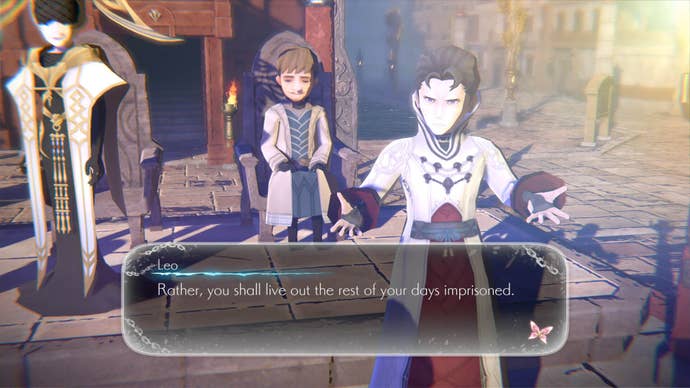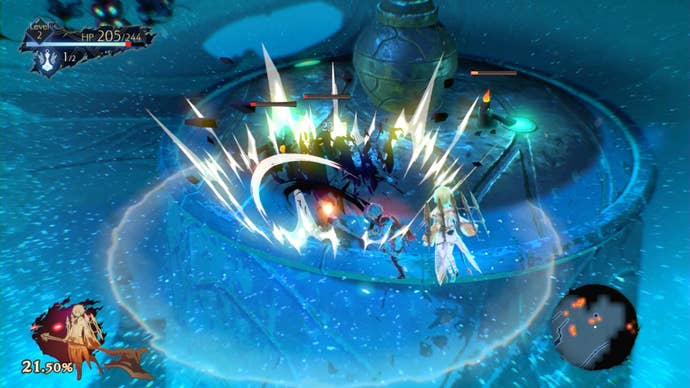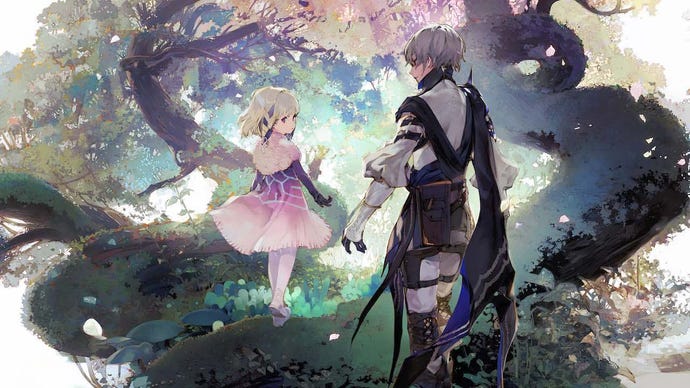Oninaki Review
Oh now feel it, comin' back again.
This article first appeared on USgamer, a partner publication of VG247. Some content, such as this article, has been migrated to VG247 for posterity after USgamer's closure - but it has not been edited or further vetted by the VG247 team.
I've never been sure what kind of image Tokyo RPG Factory wants to project with its name. When I think of an "RPG factory," I think about games assembled quickly, cheaply, and without individuality. To be frank, "cheap and manufactured" was the impression I got from Tokyo RPG Factory's first game, 2016's Chrono Trigger clone I Am Setsuna. Tokyo RPG Factory's 2017 follow-up, Lost Sphear, didn't command more than a few hours of my attention either.
Oninaki feels like the first time Tokyo RPG Factory made an effort to slip from all the negative connotations that come with the "Factory" in its name. There's the seed of something special here, but a few major flaws with presentation and repetitive gameplay prevent Oninaki from being the first Tokyo RPG Factory title to take flight. Still, it gets a solid B for effort, and a gold star for doing its own assignment instead of just cribbing the smart kid's work.
Oninaki's story is its strongest point. The game takes place in a universe where reincarnation after death is practically confirmed. Interestingly, this confirmation doesn't bring people peace because there are still no guarantees they'll meet and remember their loved ones in the next life. Hawkers and grifters sell charms and peddle cults that make false promises, and the Sovereign who runs the country exploits the people's fears for power.
You travel through the game as Kagachi, a young "Watcher" whose job is to send off any worried souls stuck between death and reincarnation. In time, Kagachi finds himself partnered with a mysterious girl named Linne before he's wrapped up in a struggle with a nightmare being born of the Sovereign's corruption.
While Oninaki's main plot gradually becomes familiar fare for JRPG fans (anime girls with amnesia; vengeful ghosts consumed by hatred and a lust for revenge; you know the lyrics by now), it has enough sub-plots to keep its compelling themes of death, grieving, and reincarnation near its fore. There's a surprisingly dark tale here that kicks off with Kagachi mercy-killing two grief-stricken parents who choose death because their anguish is keeping their dead son's spirit from finding peace and moving on. This segues into an incident where a cultist convinces his followers—including children—they'll find their loved ones in the afterlife if they kill themselves on the cult's terms. Oninaki's themes walk the line between being thought-provoking and "2 edgy," but thankfully they trend more towards the former than the latter. It's just a shame Oninaki's poorly balanced gameplay fails to carry its plot with the smoothness it deserves.
It’s not as if the potential isn't there, either. Whereas I Am Setsuna piggybacks directly off Chrono Trigger, Oninaki is a little bit of Diablo, a little bit of Xenoblade Chronicles 2, a little bit of Zelda—and I'll stop now before I inadvertently pen a bizarre new verse for Lou Bega's "Mambo No. 5." It's an action RPG rather than menu-based like previous Tokyo RPG Factory games, but it doesn't merely put a sword in your hand and tell you to start hacking. Instead, Kagachi befriends and commands "Daemons" that supply him with different weapons, move sets, and skills. Up to four Daemons can be equipped at one time, and when Kagachi switches out, his fighting style has the potential to change drastically.

For example, one of my favorite Daemons is Zephyr, a giant (good boy) wolf who lets Kagachi ride on his back. He specializes in close-range biting attacks as well as area-of-effect buffs and debuffs. I also like Zaav, a spear-wielder who keeps enemies at arm's length and excels in jumping attacks that let Kagachi rain down death from above. There are additional Daemons who supply Kagachi with long-range bow attacks, quick sword attacks, heavy axe attacks, and even chain attacks. Fighting with a Daemon gradually nets you Stones that let you unlock new skills from their unique skill trees. You can also use these Stones to unlock bits of lore that gradually reveal what the Daemons were like when they were still living beings.
Being a fan of Xenoblade Chronicles 2's Blades, there's a lot I like about Oninaki's Daemons. I admit I quickly became overwhelmed by the number to choose from, but I soon discovered it's fine to stick with a few favorites. Oninaki's biggest problem, the mind-numbing physical resilience of the enemies you battle, isn't alleviated no matter who fights by your side.
Regardless of which Daemons you equip, no matter how much you level up, no matter how often you upgrade your Daemons' weapons, fights in Oninaki remain a slog. Even the lowliest foes soak up a crazy amount of damage. Every knot of monsters you come up against halts the game's flow like a crash dummy slamming into a brick wall. Switching the game to "Casual" difficulty makes battles move a little more quickly, but you can still feel your life ebb away as you clear out one nest after another. It also helps to use Kagachi's ability to move beyond the Veil (a world of the dead where restless spirits reside), since his Daemons' attacks are stronger in their natural habitats. But whatever adjustments you make, you still button-mash ad nauseum.

The grind of Oninaki's combat is compounded by its uninteresting visuals. Tokyo RPG Factory is still a studio that works on a budget, and it shows in Oninaki's frequently recycled character models, bland enemy designs, and same-y terrain. One mountain path looks like the next, even when Kagachi slips behind the Veil and basks in the Beyond's weird colors and diffuse lighting. It's a shame to see an RPG with such a unique concept tell its story with such lifeless visuals.
Oninaki's plain graphics could be overlooked if its gameplay moved as swiftly and easily as a Diablo title, but that's not exactly the case. Tokyo RPG Factory penned a good story and built a good world, but even an RPG can't live by narrative alone.
Despite my criticism, Oninaki isn't irredeemable. A personal playlist or a podcast (might I make a recommendation?) might help you through the slog. Besides, I'm happy to see Tokyo RPG Factory take a step in the right direction. At the risk of sounding like a condescending teacher: Keep going, guys. You might nail it next time.
ConclusionOninaki is a likable RPG. Its story and setting are interesting, and the Daemons you collect to help you fight are cool. Unfortunately, bashing through uninteresting swarms of high-HP enemies puts a damper on the fun. Oninaki is still better than Tokyo RPG Factory's previous games; the studio seems to be moving in the right direction. If it can get past its extended growing pains, it'll be a contender someday.


